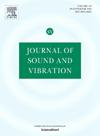非均匀动力荷载作用下一维和二维构件复杂动力响应预测的简化等效SDOF系统
IF 4.3
2区 工程技术
Q1 ACOUSTICS
引用次数: 0
摘要
爆炸荷载下结构单元的动力响应包括多种振动模态。等效单自由度(SDOF)系统是一种流行的快速运行的工程设计工具,用于捕获结构单元的整体行为,假设单一和主导振动模式(MOV)。典型的模型包括非均布荷载和跨中集中荷载。在近距离爆轰的情况下,主要的振动模式不同于均匀载荷。本文建立了考虑非均匀动荷载的等效SDOF系统。对近爆轰动载荷特性进行了文献综述。利用非均匀荷载,在荷载均匀性的基础上推导出变换系数。接下来,分析地开发了一种简化的方法,其中假定负载是均匀的,允许解决一个更简单的系统(类似于设计手册和商业软件中的常见做法)。施加等效均布荷载以达到相同的峰值位移。该方法也被用于一维构件的非中心爆轰。文中提出的方法通过详细的一维和二维单元多自由度模型进行了验证。本文章由计算机程序翻译,如有差异,请以英文原文为准。
Simplified equivalent SDOF system for predicting complex dynamic response of 1D and 2D elements under nonuniform dynamic load
The dynamic response of blast-loaded structural elements includes multiple modes of vibrations. An equivalent Single Degree of Freedom (SDOF) system is a popular fast-running engineering tool for design to capture the global behavior of the structural element, assuming a single and dominant Mode of Vibration (MOV). Typical models include a nonuniform load or a concentrated load at the midspan. In a close-in detonation scenario, the dominant mode of vibration differs from uniform loading. This paper develops an equivalent SDOF system to account for a nonuniform dynamic load. A literature review on the characteristics of the dynamic load from close-in detonation is provided. The non-uniform load is used to develop transformation factors based on the uniformity of the load. Next, a simplified approach is analytically developed, where the load is assumed to be uniform, allowing for a simpler system to be solved (similar to common practices in design manuals and commercial software). An equivalent uniform load is applied to achieve the same peak displacement. The method has also been developed for the noncentral detonation of 1D members. The method presented in the paper is validated with detailed Multi-Degree-of-Freedom (MDOF) models of one and 2D elements.
求助全文
通过发布文献求助,成功后即可免费获取论文全文。
去求助
来源期刊

Journal of Sound and Vibration
工程技术-工程:机械
CiteScore
9.10
自引率
10.60%
发文量
551
审稿时长
69 days
期刊介绍:
The Journal of Sound and Vibration (JSV) is an independent journal devoted to the prompt publication of original papers, both theoretical and experimental, that provide new information on any aspect of sound or vibration. There is an emphasis on fundamental work that has potential for practical application.
JSV was founded and operates on the premise that the subject of sound and vibration requires a journal that publishes papers of a high technical standard across the various subdisciplines, thus facilitating awareness of techniques and discoveries in one area that may be applicable in others.
 求助内容:
求助内容: 应助结果提醒方式:
应助结果提醒方式:


